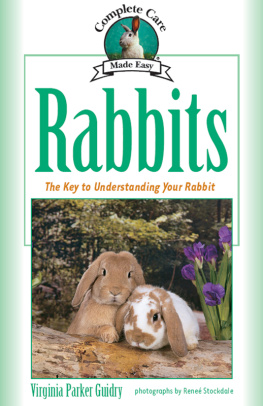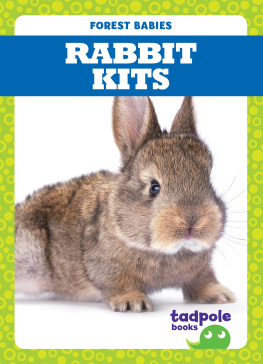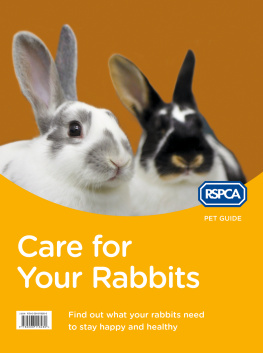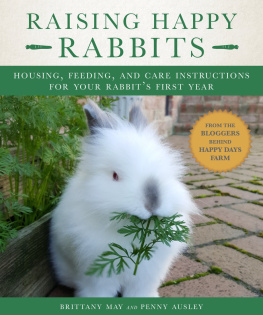Raising a Healthy Rabbit
Excerpted from Your Rabbit, by Nancy Searle
CONTENTS

Why Rabbits?
Raising rabbits is gaining in popularity for many reasons. For example, rabbits can be raised in any type of environment, whether it be country, suburb, or city, and they fit easily into most family settings. A rabbit makes a friendly, low-maintenance family pet and is a good size animal for children as well as adults to care for. In addition, it doesnt take a lot of money to get started with rabbits this project will fit into most family budgets. Although proper equipment contributes to the success of raising rabbits, it is more important for equipment to be functional than fancy.
Choosing the Right Rabbit
There is an unusually broad range of choices for rabbits. Much depends on whether you want a pet or a wool business. Also influencing your choice may be:
 Availability. Is your chosen breed raised in your area? If you select a breed that is popular locally, you will have a greater choice of quality animals.
Availability. Is your chosen breed raised in your area? If you select a breed that is popular locally, you will have a greater choice of quality animals.
 Cost of animal. You will find that some breeds command higher prices than others.
Cost of animal. You will find that some breeds command higher prices than others.
 Cost of care. Other factors, such as breed size, also affect overall costs, since larger breeds need larger housing and consume more feed.
Cost of care. Other factors, such as breed size, also affect overall costs, since larger breeds need larger housing and consume more feed.
 Amount of care. Angoras, which must be groomed daily, take more time than do other breeds.
Amount of care. Angoras, which must be groomed daily, take more time than do other breeds.
 Ease of raising. Some breeds, such as Netherland Dwarfs and Holland Lops, can be difficult to raise.
Ease of raising. Some breeds, such as Netherland Dwarfs and Holland Lops, can be difficult to raise.
After you have evaluated your own needs and preferences, youll want to select a breed, locate breeders with stock for sale, and then visit a rabbitry to choose your rabbit.
Good Breeds for Pets
An increasing number of people keep rabbits as pets. As pets, rabbits can be kept indoors or out, they make no noise, they have few veterinary needs (including no vaccination), their initial cost is low, and daily care is not demanding. These features make rabbits ideal pets for busy, modern families. Any breed may be kept as a pet, but if you want to raise rabbits primarily to sell as pets, you are wise to consider some of the smaller breeds. These include: Netherland Dwarf, Dutch, Mini Lop, and Holland Lop.
Good Breeds for Fiber
In recent years, natural fibers and handcrafted items have become very popular. This has brought about a new appreciation for the Angora rabbit breeds. Soft and warm, Angora wool is obtained by pulling the loose hair from the mature coat. Because you are really just helping the natural shedding process, this hand plucking does not hurt the animal. The plucked wool can then be spun into yarn. Although Angora rabbits require some special management (they need to be groomed often), raising them and selling their wool is an excellent business venture.
How Many Rabbits Do You Want?
Whether you are looking for a pet or want to start a small rabbit business, you may want to begin with one rabbit. This allows you to experience both the fun and the work that goes with rabbit ownership. If you enjoy caring for one rabbit, you can get more rabbits as time goes on.
Some new rabbit owners who intend to start a breeding program choose to start with more than one. A reasonable number to begin with is three rabbits, consisting of one buck (male) and two does (female), known as a trio. Ask the breeder to help you select three rabbits that are not too closely related. Look at the animalspedigrees. The rabbits in your trio may have some relatives in common, but their pedigrees should show some differences in their family trees as well. Your trio should not be brother and sisters. Three rabbits from the same litter are too closely related to be used for breeding purposes.
Whatever number of rabbits you begin with, remember that each rabbit will need its own cage. Dont purchase more animals than you are able to care for properly.
Recognizing a Healthy Rabbit
Good health is the most important quality to consider when you select your stock. Look for the following features to determine a healthy rabbit.
 Eyes. The eyes are bright, with no discharge and no spots or cloudiness.
Eyes. The eyes are bright, with no discharge and no spots or cloudiness.
 Ears. The ears look clean inside. A brown, crusty appearance could indicate ear mites.
Ears. The ears look clean inside. A brown, crusty appearance could indicate ear mites.
 Nose. The nose is clean and dry, with no discharge that might indicate a cold.
Nose. The nose is clean and dry, with no discharge that might indicate a cold.
 Front feet. These are clean. A crusty matting on the inside of the front paws indicates that the rabbit has been wiping a runny nose, and thus may have a cold.
Front feet. These are clean. A crusty matting on the inside of the front paws indicates that the rabbit has been wiping a runny nose, and thus may have a cold.
 Hind feet. The bottoms of the hind feet are well furred. Bare or sore-looking spots can indicate the beginning of sore hocks.
Hind feet. The bottoms of the hind feet are well furred. Bare or sore-looking spots can indicate the beginning of sore hocks.
 Teeth. The front teeth line up correctly, with the front top two teeth slightly overlapping the bottom ones.
Teeth. The front teeth line up correctly, with the front top two teeth slightly overlapping the bottom ones.
 General condition. The rabbits fur is clean. Its body feels smooth and firm, not bony.
General condition. The rabbits fur is clean. Its body feels smooth and firm, not bony.
 Rear end. The area at the base of the rabbits tail should be clean, with no manure sticking to the fur.
Rear end. The area at the base of the rabbits tail should be clean, with no manure sticking to the fur.
Getting Acquainted

A new rabbit has many adjustments to make. Give your rabbit a few days to get used to you and its new surroundings before you handle it a lot.
Get to know your rabbit in a setting where both of you can be comfortable. A good place to get acquainted is at a picnic table covered with a rug, towel, or some other covering that will give the rabbit secure, not slippery, footing. Your rabbit will be able to move around safely on the table, and you can safely visit and pet your rabbit without having to lift it. Rabbits will usually not jump off a table. In spite of this, never leave a rabbit unattended when it is out of its cage.
Once your rabbit seems comfortable on the table, practice picking it up. Because the table offers a handy surface to set the rabbit safely back onto, this setting is much better than risking a possible fall to the ground.









 Availability. Is your chosen breed raised in your area? If you select a breed that is popular locally, you will have a greater choice of quality animals.
Availability. Is your chosen breed raised in your area? If you select a breed that is popular locally, you will have a greater choice of quality animals.